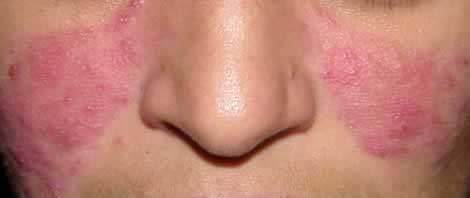Rosacea
Rosacea is a skin condition where the facial
skin is ruddy or flushed. The face's redness is sometimes accompanied
by red bumps and pimples, as well as tiny, thread-like blood vessels.
The nose can become red and swollen, accompanied with or without
stinging of the eyelid and eyes.

Because of its similarity to acne, rosacea is also often called
"acne rosacea" and is often misdiagnosed
as adult acne. Unlike acne, however, rosacea is not caused by
excess sebum or oil production which lead to plugged pores.
Symptoms of Rosacea
The symptoms of rosacea are:
- Redness on the face
- Tiny, thread-like blood vessels, called telangiectasias
- Red and bumpy nose appearance, called rhinophyma
- Irritated and red eyelids, often with gritty or stinging sensation
in the eyes
Left untreated, rosacea gradually gets worse and can cause the
skin to become thick and distorted.
Who Gets Rosacea?
This skin condition is progressive - meaning it gets worse with
age. It affects most often in young and middle-age women with
fair-skin, however it can also affect men. Indeed, rosacea is
usually more severe in men.
What Causes It?
The exact cause of rosacea is not known.
Rosacea Treatment
Self-treatment includes avoiding things that contribute to skin
redness, such as:
- sun exposure
- alcohol intake,
- drinking hot beverages
- eating spicy foods
- excessive skin scrubbing
Reducing stress and avoiding extremely hot or cold temperatures
may also.
Prescription medicine for rosacea include:
- Oral antibiotics, such as tetracycline and erythromycin
- Metronidazole gel or cream
Treatment for visible blood vessels or telangiectasias include
using laser or electric current to destroy the vessels.


